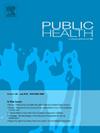暴力受害轨迹在生命历程和过去一年的牙科护理使用在美国成年人
IF 3.2
3区 医学
Q1 PUBLIC, ENVIRONMENTAL & OCCUPATIONAL HEALTH
引用次数: 0
摘要
接触暴力与较差的健康结果和较低的医疗保健使用率有关。然而,研究还没有评估生命过程中暴力受害模式与牙科护理使用之间的关系。本研究旨在通过研究从青春期到成年期的暴力受害轨迹与成年期牙科护理使用之间的关系来填补这一空白。研究设计前瞻性队列研究。方法数据来自参与全国青少年至成人健康纵向研究(1994-2018年;年龄11-43;n = 5847)。基于群体的轨迹模型(GBTM)确定了从青春期到成年期的暴力受害模式,多重逻辑回归探讨了这些轨迹与过去一年在Wave V的牙科护理使用之间的关系,调整了人口统计学、社会经济和健康相关因素。结果确定了四种受害轨迹:无受害、中等低受害、青少年有限受害和慢性受害。在过去的一年中,牙科保健的使用率在没有受害的人中最高(66.9%),在长期受害的人中最低(49.5%)。相对于没有暴力受害的轨迹,在生命历程中任何时刻经历暴力受害的所有其他受害轨迹组使用牙科护理的几率都明显较低。结论生命过程中的暴力受害与成年期牙科保健使用率降低有关。本文章由计算机程序翻译,如有差异,请以英文原文为准。
Violent victimization trajectories over the life course and past year dental care use in adulthood in the United States
Objectives
Exposure to violence has been linked to poorer health outcomes and reduced healthcare utilization. Yet research has not assessed how patterns of violent victimization over the life course are associated with dental care use. This study aims to fill this gap by examining the relationship between violent victimization trajectories from adolescence to adulthood and dental care use in adulthood.
Study design
Prospective cohort study.
Methods
Data are from respondents who participated in Waves I-V of the National Longitudinal Study of Adolescent to Adult Health (Years 1994–2018; ages 11–43; n = 5847). Group-based trajectory models (GBTM) identified patterns of violent victimization from adolescence to adulthood, and multiple logistic regression explored the association between these trajectories and past year dental care use at Wave V, adjusting for demographic, socioeconomic, and health-related factors.
Results
Four victimization trajectories were identified: No victimization, intermediate low victimization, adolescent limited victimization, and chronic victimization. Past year dental care use was highest among those with no victimization (66.9 %) and lowest among those with chronic victimization (49.5 %). Relative to the trajectory of no violent victimization, all other victimization trajectory groups that experienced violent victimization at any point during the life course had significantly lower odds of dental care use.
Conclusions
Violent victimization across the life course is associated with reduced dental care utilization in adulthood.
求助全文
通过发布文献求助,成功后即可免费获取论文全文。
去求助
来源期刊

Public Health
医学-公共卫生、环境卫生与职业卫生
CiteScore
7.60
自引率
0.00%
发文量
280
审稿时长
37 days
期刊介绍:
Public Health is an international, multidisciplinary peer-reviewed journal. It publishes original papers, reviews and short reports on all aspects of the science, philosophy, and practice of public health.
 求助内容:
求助内容: 应助结果提醒方式:
应助结果提醒方式:


